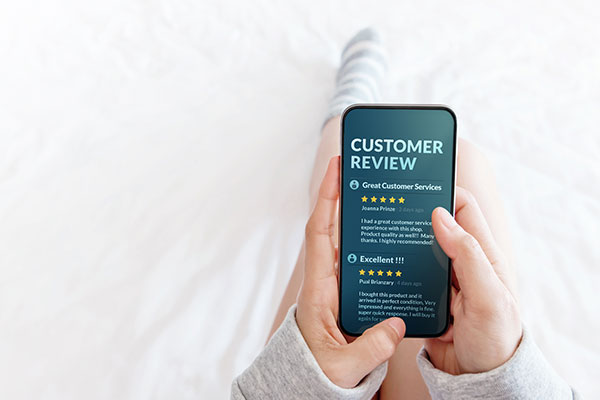For nearly 9 in 10 consumers, an online review is as important as a personal recommendation.
Reviews and ratings help consumers make confident, informed purchases as they allow people to see what goes on behind the curtain. Your website shows what you have to say about your business, goods, or services, while reviews and ratings are everyday customers’ experiences.
Reviews and ratings are the NUMBER ONE feature that consumers go to when trying to expedite their decision-making process. This means reviews are more important to shoppers than even chatbots, product page descriptions, or the website search tool.
Customers are likely to spend 31% more on a business with great reviews.
Benefits of Reviews
On average, a one-star increase on Yelp leads to a 5-9% increase in a business’s revenue.
Reviews do all of the following for your company:
- Help customers decide on your service.
- Prove that you are credible.
- Validate whether or not you are trustworthy.
- Improve your SEO and place you in front of consumers.
Pros/Cons of Reviews
Pros
- Free advertising
- Peer recommendations
- Better search engine results
- Constructive feedback
- Building relationships with customers
Cons
- Negative reviews can alter a prospect’s view of the company
- “Housekeeping” to keep reviews current and up to date
- A lot of freedom for customers to say whatever they want
- A lack of negative reviews shows a lack of visibility
- Cost of third-party review sites
How To Ask For Reviews
The beauty of each of these options is that they can all be automated. Even over the phone, an automated service can ask the caller if they would like to hold at the end of the call to leave a brief review.
The perfect opportunity to request a review through any of these mediums would be after successfully completing a sale or service.
- Over the phone (or via text)
- In-person
- Through a website (reviews page)
- Email (blast, personal, company, email signatures)
- Social media (direct message or post)
- Thank you pages
- Receipts/invoices
 Responding To Negative Reviews: What Not To Do
Responding To Negative Reviews: What Not To Do
Let’s start with what not to do.
Don’t take it personally.
Upon receiving a negative review, similar to receiving a negative comment in any personal relationship, it’s our human nature’s initial response to take it personally.
Don’t.
Remember, this is not personal, this is business.
Don’t get defensive.
What step comes after taking it personally? Defending.
As a result of feeling like you’ve done something wrong from a business standpoint, it can feel tempting to defend yourself, goods, services, or business.
Don’t.
Instead, listen critically, assess your business approach thoroughly, and correct the issue with incredible customer service.
Instead of jumping at the opportunity to speak, which can lead to defending, listen first.
Turn A Negative Into A Positive
Here’s what TO do.
Listen
1. Reread, reread, reread. Take notes. Digest. LISTEN.
While a negative review should be acknowledged promptly, your solution and response should be critically reviewed and thoughtfully addressed. Don’t stay in this step for too long, but it needs to be said that you don’t have to respond that very minute.
Listening is QUITE an underrated skill these days.
Prepare
2. Plan the solution–by yourself or with your team. If with a team, communicate effectively.
The key here is to plan your solution BEFORE providing a point of contact to the client.
While it’s understandable that receiving such a review can be alarming and make you want to respond immediately, make sure you slow down. Have your plan in place before posting contact information in the comments to ensure that you and your team are fully prepared before speaking with the customer.
3. Decide on the point of contact that the customer can reach out to. If this will be taken care of by someone else, get that colleague up to speed.
Having your response ready also means that you and your team, if applicable, are all on the same page on who will be taking care of the issue.
You want to make the most of this direct communication with your customer and address their concerns in a seamless and organized manner.
Save them the hassle of being tossed around on the phone. Know exactly who will help, and make sure they know exactly what to do to help.
Respond
4. Begin your response with personalization and gratefulness.
Use the reviewer’s name or pseudonym when possible. This shows that you are not copying and pasting a generic response, and are instead speaking to them directly.
You don’t need to apologize yet at this stage. In the very beginning, it doesn’t need to be about you, your business, or how you’ve come up short.
Focus on your client at first, not your business. Many businesses go straight into empathy with the problem.
That is a CRUCIAL step, but we recommend starting with gratitude before getting right into the issue.
Tips and Examples:
- “Hi ____, we just wanted to thank you for taking the time to speak honestly about the issue you faced so that we can do better in the future.”
5. Have empathy.
Now that you’ve addressed the client directly, and led with gratitude, it’s time to take full advantage of this opportunity to talk to this person directly by showcasing that your company is not an automated robot.
Feel their pain points with them. Be human.
Tips and Examples:
- “Oh no! That does sound frustrating.”
6. Acknowledge their specific issue.
This is not about your opinion on their issue. It’s about making sure you understand why they are unhappy. This puts you and your client on the same side, attacking the problem together.
Tips and Examples:
- Rephrase the problem in your own words for clarity.
- Emphasize the severity of the problem.
- “That is challenging. Let’s get that taken care of right away.”
- Be succinct. Your entire response should only be a few sentences.
7. Provide the point of contact to take things offline.
Now that you’ve listened, planned your ideal solution to present to the customer, and led your response with humanness, it’s time to take things offline. Provide a clear point of contact and how to best get in touch with that person.
8. Apologize and make amends.
Having this for last allows the proactive parts to be the beginning. Close out with this to show your humility and, again, humanness.
Tips and Examples:
- “We’re sorry to hear about the issue you experienced…”
Customer Service: Righting The Wrong
9. Now that the public exchange is over, it’s time to give the best customer service you have. Provide your solution.
 Bring out the big guns. Go above and beyond (while staying realistic).
Bring out the big guns. Go above and beyond (while staying realistic).
Tips and Examples:
- The solution should be easy for the customer. They are already
having a hard time, don’t add more work to that.
Create Space For Additional Feedback
- Ask if the recommended solution aligns with their needs.
Show your customer that it is not your business’s way or the highway by asking if the solution works for them.
This allows the customer to voice any further questions, concerns, or even logistical details that need to be addressed.
This final step also opens the line of communication from their end so that your business can receive feedback. From here, you can learn the pros and cons of your approach and make any adjustments should the issue arise again with a different consumer.
Let’s Sum It Up
Reviews help give customers meaningful insight into your company. Like an open kitchen at a restaurant, your clientele wants to know what goes on behind the scenes. Reviews strengthen prospects’ decision-making when choosing your business, boost your credibility and trustworthiness, and strengthen your SEO and search engine results.
Whether you’re a consumer, a business owner, or both, NEVER underestimate the power of customer reviews.
Gravity Junction and Online Reputation Management
The Gravity Junction team is equipped and ready to safeguard your reputation. Our wordsmiths can handle crafting appropriate responses in order to manage your reviews. Let’s talk and discuss how, together, we can use your reviews as an opportunity for your brand to shine.
Creating brand messages in response to reviews is an extension of your brand identity. For further help on the topic, head over to our brand identity blog!





 Responding To Negative Reviews: What Not To Do
Responding To Negative Reviews: What Not To Do Bring out the big guns. Go above and beyond (while staying realistic).
Bring out the big guns. Go above and beyond (while staying realistic).




0 Comments